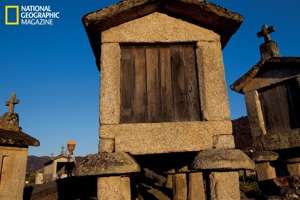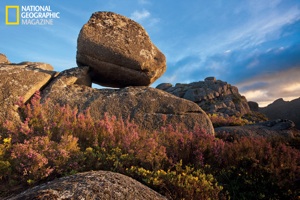Editor's note: The United States does not hold a monopoly on national parks. Indeed, its parks movement has spread around the globe. Portugal can't quite count as many national parks as the United States, but its one park, Peneda-Gerês, preserves both magnificent landscapes and a way of life long enjoyed in Pitõs das Júnias. Tom Mueller recently visited the park for National Geographic, which carries his story in its July issue, which is on newsstands now. Here's an excerpt to whet your appetite.
The Delicate Balance of Portugal's Premier Park
Portugal’s first—and only—national park is a combination of natural wonders and local lifestyles.
The village of Pitões das Júnias is in Peneda-Gerês, Portugal's first and only national park. At 270 square miles, it's small compared to sprawling parks such as Yellowstone, the world's first national park. But packed within its borders is a highly concentrated mixture of things wild and domesticated.

Perched on stone posts to keep mice at bay, traditional corncribs and their nearby threshing floors have been centers of agricultural life since the 17th century—shortly after Portuguese and Spanish explorers brought back corn from the New World. Photo by Peter Essick/National Geographic.
Forty endangered Iberian wolves share the terrain with some 11,000 people, who live in more than 80 settlements formed long before the park was established in 1971. In fact, people and wildlife have lived in close proximity here since the Stone Age. Whether they exist today in delicate equilibrium or constant tension depends on whom you ask.
Tucked into a craggy corner of northern Portugal, hard against the Spanish border, Peneda-Gerês is carved by mountain ranges, rivers, canyons, gorges, and streams. Most villages are situated in the lower valleys, where the climate is milder and the terrain more accommodating to people and livestock.

A blend of wilderness and civilization, Portugal's Peneda-Gerês National Park faces a tricky challenge: protecting nature while accommodating people. Photo by Peter Essick/National Geographic
The park's wild heart is in the high country, a realm of rugged granite massifs, windswept moors, and bare uplands greened in places by stands of giant holly.
Gerês, as the park is commonly referred to, can be found in the northwestern corner of Portugal. Drawing tourists are not only the many waterfalls and streams that course through the landscape, but also ruins that date to as early as 4,000 BC.
You can find more of Peter Essick's images from Peneda-Gerês National Park at this site.


 Support Essential Coverage of Essential Places
Support Essential Coverage of Essential Places







Comments
Thanks for the references to the National Park Peneda Gerês.It's a paradise to discover.
Hotel Castrum Villae/Facebook:
https://www.facebook.com/pages/Hotel-Castrum-Villae/94319351174
Great article about our Pan Park. Thanks! :)